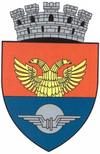Pașcani
For other uses, see Pașcani (disambiguation).
| Pașcani | ||
|---|---|---|
| Municipality | ||
|
A part of Pașcani seen from the stairs | ||
| ||
 Pașcani Location of Pașcani | ||
| Coordinates: 47°14′58″N 26°43′38″E / 47.24944°N 26.72722°ECoordinates: 47°14′58″N 26°43′38″E / 47.24944°N 26.72722°E | ||
| Country |
| |
| County | Iași County | |
| Status | Municipality | |
| Government | ||
| • Mayor | Dumitru Pantazi | |
| Population (2011 census[1]) | ||
| • Total | 33,745 | |
| Time zone | EET (UTC+2) | |
| • Summer (DST) | EEST (UTC+3) | |
| Website | http://www.pascani.ro/ | |
Pașcani (Romanian pronunciation: [paʃˈkanʲ]) is a city in Iași County in the Moldavia region of Romania, on the Siret river. As of 2011, it has a population of 33,745. Five villages are administered by the city: Blăgești, Boșteni, Gâstești, Lunca and Sodomeni.
The city derived its name from the estate of the boyar Oană Pașca. It is the city where Mihail Sadoveanu's novel The Place Where Nothing Happened takes place.
| Historical population | ||
|---|---|---|
| Year | Pop. | ±% |
| 1930 | 13,968 | — |
| 1948 | 10,857 | −22.3% |
| 1956 | 15,008 | +38.2% |
| 1966 | 18,689 | +24.5% |
| 1977 | 24,459 | +30.9% |
| 1992 | 44,900 | +83.6% |
| 2002 | 42,172 | −6.1% |
| 2011 | 33,745 | −20.0% |
| Source: Census data | ||
Natives
References
- ↑ "Population at 20 October 2011" (in Romanian). INSSE. 5 July 2013. Retrieved 9 July 2013.
External links
| Wikimedia Commons has media related to Pașcani. |
This article is issued from Wikipedia - version of the Wednesday, November 18, 2015. The text is available under the Creative Commons Attribution/Share Alike but additional terms may apply for the media files.


